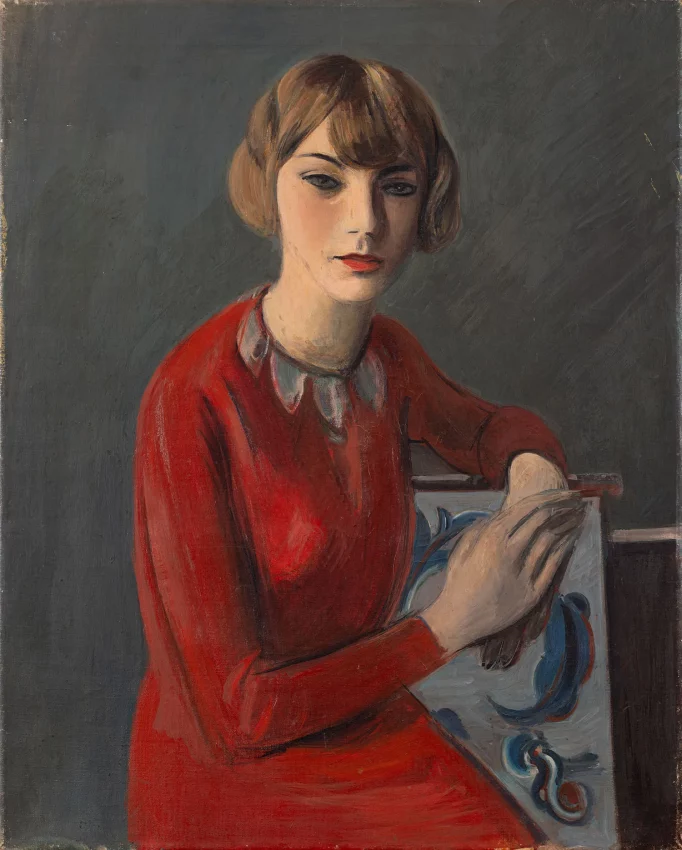150 years of Rudolf Levy TU Braunschweig and museum network commemorate an important modern artist
The painter Rudolf Levy was born 150 years ago, on 15 July 1875. His painting ‘Bildnis Lilo’ (Portrait of Lilo) from the 1930s was the star of the ‘rediscovered’ Straßner Collection of TU Braunschweig, which was exhibited at the Städtisches Museum Braunschweig in early 2025. Around twenty museums have joined forces to mark his birthday with a joint social media campaign commemorating the important painter of classical modernism – and his life between glory and fate.

Rudolf Levy, Portrait of Lilo, around 1930, oil on canvas, 79 x 63 cm, Straßner Collection of Technische Universität Braunschweig.
Image credit: Marek Kruszewski/TU Braunschweig
The young woman portrayed in the bright red dress looks directly at us from the picture. Her gaze – self-assured and melancholic at the same time – establishes a connection with the viewers in front of the picture. According to the title, her name is Lilo and the picture was probably painted around 1930. We know nothing more about the woman portrayed and her connection to Rudolf Levy. But we do know the artist’s story.
Celebrated, persecuted, murdered
Rudolf Levy (1875–1944) is one of the most influential artists of the modern era: at the beginning of the 20th century, he frequented the Café du Dôme in Paris alongside Matisse, Picasso, Purrmann and others. During the ‘Golden Twenties,’ he enjoyed great success in Berlin, for example with exhibitions at the Flechtheim Gallery. His circle of friends included the colourful siblings Erika and Klaus Mann, the sculptor Renée Sintenis and Max Pechstein. Like many other persecuted artists, Levy’s career came to an abrupt end when the National Socialists seized power. Rudolf Levy was persecuted as a Jew and as a so-called ‘degenerate’ artist.
After an odyssey through Europe and the USA, he was finally able to settle in Florence. There, his work experienced a final impressive high point. At the end of 1943, he was arrested by the Gestapo in Florence and deported. His transport reached the Auschwitz extermination camp on 6 February 1944. He may not have arrived there alive or may have been murdered shortly after his arrival.
In 1957, Prof. Ernst Straßner acquired the ‘Portrait of Lilo’ for the collection of the Pädagogische Hochschule Braunschweig through the Hanna Bekker vom Rath Gallery in Frankfurt am Main. The previous owner was Heinz Battke, a close friend of Levy’s and collector of his works. As part of this collection, it was shown from 14 March 2025 to 8 June 2025 in the exhibition ‘Ausgehoben! Realismen von Aristide Maillol bis Gruppe ZEBRA’ (Excavated! Realism from Aristide Maillol to the ZEBRA Group) at the Städtisches Museum Braunschweig, where it will be on permanent display in the future – right next to another work by Levy from the museum’s collection.
Levy network commemorates the artist’s fate under National Socialism
With the ‘rediscovery’ of Rudolf Levy’s ‘Portrait of Lilo,’ TU Braunschweig became part of a network of museums and collecting institutions that preserve paintings and drawings by this important artist of classical modernism. This alliance, initiated by the Museum Pfalzgalerie Kaiserslautern (MPK), aims to help keep alive the memory of this artist and the many others who were persecuted and murdered during the Nazi dictatorship.
To mark the 150th anniversary of Levy’s birth, the participating institutions are presenting a short film produced especially for this occasion on their social media channels, which brings the life and work of the painter to a wider audience. The film was directed by Sören Fischer and Philip Nicolai from the MPK. The film was generously funded by the company Scheid Gewürze, Überherrn. The film contains impressive AI-supported film sequences that bring us closer to Rudolf Levy than ever before.
In addition to TU Braunschweig and the Städtisches Museum Braunschweig, the following institutions are also participating: Museum Kunst der Verlorenen Generation, Salzburg; Kunstmuseum Moritzburg Halle (Saale); Wilhelm-Hack-Museum, Ludwigshafen; Leopold-Hoesch-Museum, Düren; Kunstforum Ostdeutsche Galerie, Regensburg; Lehmbruck-Museum, Duisburg; Buchheim Museum of Imagination, Bernried; Municipal Art Collection Gelsenkirchen/Art Museum Gelsenkirchen; Hessian State Museum Darmstadt; Saarland Museum, Saarbrücken; Municipal Museum Braunschweig; Technical University Braunschweig; Städel, Frankfurt; Kunsthalle Mannheim; Municipal Gallery in the Lenbachhaus and Kunstbau Munich; State Art Gallery Karlsruhe; Lindenau Museum, Altenburg; Suermondt-Ludwig Museum, Aachen; Museum Wiesbaden; Landesmuseum Mainz; Pommersches Landesmuseum, Greifswald; Museum Pfalzgalerie Kaiserslautern.
Link to Video: https://www.youtube.com/watch?v=reZmxvy6M_U
